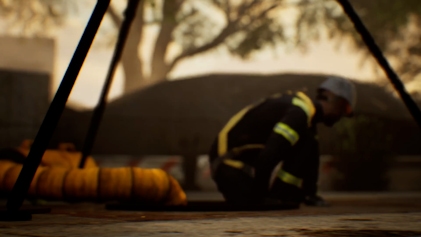It seems fair to question the safety of virtual reality as VR has recently been gaining traction in the safety training space. Through a fully immersive experience, users are engaging in a three-dimensional environment using VR headsets. The technology has existed for years now, and it’s been already 10 years that Facebook (now known as Meta) has heavily invested in the technology through the acquisition of Oculus.
Over the years the tech (and experience) has improved leaps and bounds but despite that, one of the main concerns that has arisen from wearing the headset is that people may experience nausea or disorientation; or be putting themselves in harm’s way.
And with the popularity of the technology increasing, the question “is VR dangerous?” is indeed a concern we should address.
So is VR safe?
Simply put, it can and should be.
But let’s dive right in.
Addressing reports of dizziness and nausea
It has been reported that in some cases, the use of VR headsets can lead to dizziness, nausea, and disorientation, which can be uncomfortable or even harmful to individuals with pre-existing medical conditions.
→ But here's a thing: your experience depends fully on how well the VR experience is built as well (and most importantly) the quality of the graphics. If your experience is tainted by nausea or dizziness, it may mean that it just wasn't developed properly.
And what about physical injuries, you may ask?
There have also been reports of injuries caused by VR equipment malfunction or a lack of awareness of the user’s surroundings.
However, when the necessary precautions are taken, the risks are significantly reduced.
And VR goggles have come a long way and are constantly updated to be less heavy, less cumbersome, and better suited to wear for an extensive period of time.
And this is where Pixaera’s experience and approach come in.
Pixaera’s very premise is what makes their VR experience one of the best and safest in the space: we come in with a game design background.
Realizing how “the gaming world is disconnected from the enterprise world”, Pixaera’s founder and CEO Mousa Yassin saw an opportunity to bring the best in gaming to the safety training space, and doing so whilst alleviating all the discomfort and shortcomings of VR training to date.
“I deeply believe that gaming in the long term, especially with the technologies of VR is going to transform the way people get access to very high quality learning content” Yassin says.
This is how Pixaera addresses one of those safety concerns: coming into the VR training space from a AAA gaming perspective, we aim to produce very high quality and realistic content, both on an overall experience standpoint but also in terms of the quality of the graphics.
It is our unique story and approach that make all the difference; we are working with the best game developers so that every module is a fully immersive quality experience.




